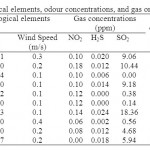Odour Pollution Measurement from Refuse Derive Fuel Operations Using Odour Concentration Meter (OCM) XP-329
Zaini Sakawi1 * , Lukman Ismail2 , Mohd Rozaimi Ariffin2 and Noor Khafazilah Abdullah2
1
Earth Observation Centre,
Universiti Kebangsaan,
Malaysia
2
School of Social,
Development and Environmental Studies,
Universiti Kebangsaan,
Malaysia
DOI: http://dx.doi.org/10.12944/CWE.8.1.02
Copy the following to cite this article:
Sakawi Z, Ismail L, Ariffin M. R, Abdullah N. K. Odour Pollution Measurement from Refuse Derive Fuel Operations Using Odour Concentration Meter (OCM) XP-329. Curr World Environ 2013;8(1) DOI:http://dx.doi.org/10.12944/CWE.8.1.02
Copy the following to cite this URL:
Sakawi Z, Ismail L, Ariffin M. R, Abdullah N. K. Odour Pollution Measurement from Refuse Derive Fuel Operations Using Odour Concentration Meter (OCM) XP-329. Curr World Environ 2013;8(1). Available from: http://www.cwejournal.org/?p=3137
Download article (pdf)
Citation Manager
Publish History
Select type of program for download
| Endnote EndNote format (Mac & Win) | |
| Reference Manager Ris format (Win only) | |
| Procite Ris format (Win only) | |
| Medlars Format | |
| RefWorks Format RefWorks format (Mac & Win) | |
| BibTex Format BibTex format (Mac & Win) |
Article Publishing History
| Received: | 2013-02-17 |
|---|---|
| Accepted: | 2013-02-28 |
There has been a dearth on studies of odour pollution in Malaysia due constraints such as lack of measurement equipments, guidelines and legal act for such operational endeavour. Despite the media publication on odour pollution, actions and enforcement were ineffective due to limitations in regulations and operationals standards.In particular, scientific studies on odour concentrations and intensity were difficult to be implemented due to lack of equipments for measuring the phenomenon. Comparatively, researchers in Japan, European Union, Australia and New Zealand have paid serious attention on odour pollutions.1
Their studies not only conducted to measure the odour concentrations, intensity, components, impact on health and people well-being but also involved in determining the accuracy in the usage of various equipments for such measurements. There were various measument methods to measure odour concentrations and intensity in terms of effectiveness in applications, comparative outcomes and systemacity. Studies conducted by2-12 were those focusing on applications of various methods to measure odour pollutions. There were not many studies on odour pollution conducted in Malaysia. A study on odour concentrations emanated from an open dumpsite was conducted by.13 Other than that, a study on a population sensory perception was conducted to identify the odour impact, intensity and meteorological factors.1,14
This study is therefore aimed to measure the odour intensity from the RDF operation to further highlight issues of odour concentrations measurement in Malaysia. The measurement was conducted at various times in the morning, evening and night. The differences in odour concentrations were measured according to the prevailing situations of either normal days or after rains. The measurementswere conducted at sampling stations per distances from the RDF operation, and also recorded were the meteorological data to identify the other factors involved in influencing the odour concentrations.
Material and Methods
Refuse Derived Fuel (RDF) is a method of power generation involving a process of combustion of solid wastes to produce electricity. The amount of electricity generated depends on the capacity and quantity of wastes being used. The RDF operation in this study was capable to generate electricity at a maximum of 9 megawatt (MW) through utilization of 700 tonnes of solid wastes per day. Parts of the power were used to run its own operation (3.5 MW) and the rest (5.5 MW) was sold to the Tenaga Nasional Berhad. The RDF is located at N 03°00’3.1’’ and longitude E 101°52’56.6’’ at 70m above sea level. Figure 1 shows the RDF location and sampling stations per the RDF.
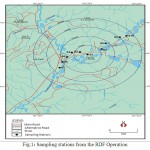 |
Figure 1: Sampling stations from the RDF Operation Click here to View figure |
Method for Measuring the Odour Concentration
The equipment for measuring the odour concentration is Odour Concentration Meter (OCM) XP-329 III. The equipment is also used to measure odour threshold and the measuring unit is stated in odour concentration per cubic meter or ou/m3. The OCM has the capacity to measure odour concentration from a minimum concentration of 0 to a maximum of 2000 ou/m3.
Malaysian Standards on Odour Pollution and Gas
There have not been specific standards established for regulatory and enforcement guidelines on odour pollution and of gas components. Existing Malaysian guidelines such as the Recommended Malaysian Air Quality Guidelines (RMAQG) have been limited to those pertaining to several gas types: O3, CO, NO2 and SO2 (Table 1). Based on the table, there is no indication of the H2S, CH4 and NH3 being emitted from the RDF.
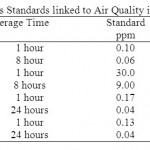 |
Table 1: Gas Standards linked to Air Quality in Malaysia Click here to View table |
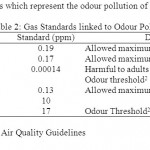 |
Table 2: Gas Standards linked to Odour Pollution Click here to View table |
Results and Discussion
The results can be divided into three major components i.e. the average of odour concentration on normal days; concentration after rains and comparative concentrations on normal days and after rains.
Average Concentrations on Normal Days
Concentrations of odour in the morning, evening and night times are shown in Tables 3, 4 and 5. The highest concentration in the morning was detected at station 5 at 43.0 ou/m3. Hot temperatures at 32.7°C and comparative humidity of 79.6 per cent (Table 3) have influenced the odour concentration at that station. The second highest concentration was at station 1 with 38.6 ou/m3. Meanwhile, values of average odour concentration recorded was (53.0 ou/m3) at Station 7 (Table 4), and maximum values was obtained up to 76.2 ou/m3 at Station 1. The low average concentrations occurred due to the influence of strong winds at the station, at 3.5 m/s.
Furthermore, the average concentrations at night time on normal days indicated a sequence of higher readings from various directions. The highest odour concentration was from the north east of the RDF location, with 68.0 ou/m3 (Station 8); followed by the south west direction with 60.6 ou/m3 (Station 7); and from the western side of the location (56.2 ou/m3) at Station 3 (Table 5). The average of lowest concentrations on the day was at station 1 with concentration values of 27.8ou/m3.
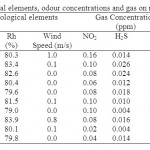 |
Table 3: Meteorological elements, odour concentrations and gas on normal days (morning) Click here to View table |
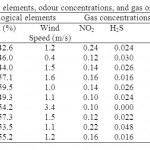 |
Table 4: Meteorological elements, odour concentrations, and gas on normal days (evening) Click here to View table |
|
|
Table 5: Meteorological elements, odour concentrations, and gas on normal days (night) Click here to View table |
Average of Odour Concentration after Rains
Meteorological elements, gas and odour concentrations, measured in the morning after rains are indicated in Table 6. Station 7 recorded highest odour concentration at 77.2 ou/m3, in addition to Station 6 at 70.8 ou/m3. Accordingly, the NO2, H2S and SO2 gas concentrations measured were at 0.16 ppm, 0.020 ppm dan 20.50 ppm respectively. The three gases recorded highest readings at station 7 compared to that of other stations. This phenomenon occured due to the influence of high temperatures and humidity; which directly stabilised the athmosphere and thus increased the concentrations of gases and odour. Table 7 shows concentrations of gas and odour in the evening after rains. Highest odour concentration was measured at station 9 (104 ou/m3), the furthest from the RDF.
The combination of temperatures, high humidity, and stable athmosphere of the recorded evenings affected the odour concentration at the station. Meanwhile, night time after rain concentrations of gas and odour did indicate an uneven pattern (Table 8). The measurement for the night time after rains concentrations indicated high odour concentrations at all stations, with the highest being at station 5 with 42 ou/m3. For gas, night time data indicated the scarce presence of H2S. Based on Table 8, it shows that 2/3 of the observation stations could detect the presence of H2S during the period.
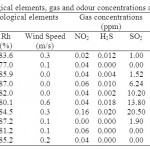 |
Table 6: Meteorological elements, gas and odour concentrations after rains (morning) Click here to View table |
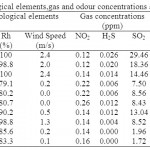 |
Table 7: Meteorological elements,gas and odour concentrations after rains (evening) Click here to View table |
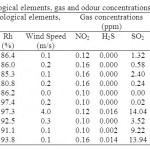 |
Table 8: Meteorological elements, gas and odour concentrations after rains (night) Click here to View table |
Comparison Between the Averages of Odour Concentrations on Normal Days and after Rains
Figure 2 shows odour concentration recorded around the RDF. Based on the figure, it shows that concentrations vary per day and time variances, with indications of the concentrations exceeded the limit set by the.15 According to the standards, the allowable concentration was set at 10 ou/m3. However, the analyses showed that the average concentration of the three sessions of measurements on normal days and after rains exceeded the limit allowable under the standards Minimum and maximum concentrations recorded on normal days was at 23.39 ou/m3 (morning) dan 64.29 ou/m3 (evening) respectively. After rains recording saw a maximum reading of 54.21 ou/m3 (evening); while minimum concentration was 31.26 ou/m3 at (night). The high concentration could adversely effect routine outdoor activities and well being of the local population.
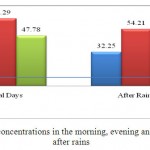 |
Figure 2: Comparison of odour concentrations in the morning, evening and night on normal days and after rains Click here to View figure |
Comparison of The Averages of H2S, SO2 and NO2 Gas Concentrations on Normal Days and After Rains
Generally, based on figure 3, figure 4 and figure 5, the gas concentrations were the highest in the evening and after rains. For example, the concentration of SO2 and NO2 reached highest reading after rains, whilst the H2S registered highest concentration on normal days. Table 3 indicated that the presence of H2S around the studied area exceeded the standard limit set by the EPA. The exceeded presence could give an impact on the health of sensitive recepients. For example, the maximum presence of H2S at 0.0232 ppm on normal days and at 0.01 ppm after rains are extremely hazardous to the sorrounding population.
Exposure to a concentration of 0.00014 ppm could give adverse effect on the health of the elderly and children (Table 2). The analysis of SO2 (Table 4) indicated that the concentrations exceeded the limit set by JAS. The rate of maximum gas concentration on normal days (8.06 ppm) and after rains (11.201 ppm) exceeded the standard limit by 0.19 ppm (Table 2). These gases extended exposure to human beings could damage not only their health but also their properties .16 An indication is ruinous effect on human skins and deterioration of buildings walls and paintwork. Based on the RMAQG standards, the overal observations indicated that the NO2 presence were below the standard limit allowable (Figure 5). The figure shows that the NO2 concentration was at maximum on normal days and the lowest after rains at 0.15 ppm and 0.16 ppm respectively (Table 2).
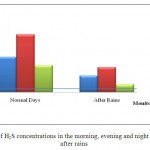 |
Figure 3: Comparison of H2S concentrations in the morning, evening and night on normal days and after rains Click here to View figure |
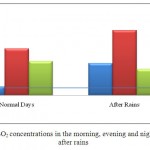 |
Figure 4: Comparison of SO2 concentrations in the morning, evening and night on normal days and after rains Click here to View figure |
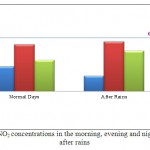 |
Figure 5: Comparison of NO2 concentrations in the morning, evening and night on normal days and after rains Click here to View figure |
Conclusion
This study has indicated that concentrations of odour produced from the RDF operation could be influenced by meteorologicalfactors such as temperatures, relative humidity and wind speed. On normal days, the concentration of odour indicated high readings in the evening that was at 76.0 ou/m3 followed by night readings at 68.0 ou/m3 and mornings at 43.0 ou/m3. After rains, the concentrations in the evening also shown highest reading at 104 ou/m3. However , the second highest reading was recorded in the morning at 77.2 ou/m3. While for the night time, concentration was at the lowest at 42 ou/m3. In addition to that, this study also revealed the concentrations of odour generated by the RDF operation have exceeded the standard limit set by the DEC at10ou/m3, either on normal days or after rains.
It was also revealed that odour pollution was also due to the release of H2S, SO2, and NO2 concentrations. SO2 and NO2 were detected at high concentrations after rains; whilst the H2S attained high concentrations on normal days. The exposure to odour concentrations and the gases for an extended period may be harmful to wellbeing and quality of the environment of sensitive receptors. Close monitoring and penalty enforcement by the authorities need to be enhanced to minimize the potential harms of odour and gas pollutions to human beings and the larger environment.
Acknowledgement
The researcher wish to gratefully acknowledgement financial support for this research by Institute of Climate Change, Universiti Kebangsaan Malaysia under grant code GGPM-2012-018.References
- Zaini Sakawi, Sharifah Mastura S.A., Othman Jaafar, Mastura Mahmud, Lukman Ismail, Mohd Rozaimi Ariffin. Perception of sensitive receiver’s on odour pollution from the open landfill site, Journal of Social Sciences and Humanities 7(1): 284-293 (2012).
- Nicolas, J., Romain, A.C., Wiertz, V., Maternova, J., Andre, P.H. Using the classification model of an electronic nose to assign unknown malodours to environmental sources and to monitor them continuously. Sensors and Actuators, 69: 366-371 (2000), http://dx.doi.org/10.1016/S0925-4005(00)00487-1
- McGinley, C.M. Standardized odor measurement practices for air quality testing. Air and Waste Management Association Symposium on Air Quality Measurement Methods and Technology, San Francisco,1-11(2002).
- Iwasaki, Y. Olfactory measurement of odor (new version), Japan: Japan Association on Odor Environment, 145-152 (2004).
- Nicolas, J., Craffe, F., Romain, A.C. Estimation of odor emission rate from landfill areas using the sniffing team method, Waste Management, 26(11): 1259-1269 (2005), http://dx.doi.org/10.1016/j.wasman.2005.10.013
- Micone, P.G. and Guy, C. Odour quantification by sensor array: An application to landfill gas odour from two different municipal waste treatment works. Sensor and Actuators, 120: 628-637 (2006).
- Littaru, P. Environmental odours assessment from waste treatment plants: Dynamic olfactometry in combination with sensorial “electronic noses”. Waste Management, 27:302-309 (2007), http://dx.doi.org/10.1016/j.wasman.2006.03.011
- Romano, A.C. Delva, J., and Nicolas, J. Complementary approaches to measure environmental odour emitted by landfill areas. Sensor and Actuators, 131: 18-23 (2007).
- Snider, R., Culos, B., Trovarelli, A., Soldati, A., Sironi, S., Capelli, L. Evaluation of odour emissions from a landfill through dynamic olfactometry, dispersion modeling and electronic noses. Chemical Engineering Transaction, 15: 315-321 (2008).
- Nicolas, J., Romano, A.C., Delva, J., Collart, C., Lebrun, V. Odour annoyance assessment around landfill sites: Methods and results. Chemical Engineering Transaction, 15: 29-36 (2008).
- Zarra, T., Naddeo, V. and Belgiorno, V. Management, measurement and control of odour in wastewater treatment plants by portable GC-MS. Chemical Engineering Transaction, 15: 63-70 (2008).
- Zaini Sakawi, SharifahMastura S.A., Othman Jaafar, Mastura Mahmud. An analysis of odour concentration using odour concentration meter XP-329 at landfill vicinity. Research Journal of Applied Sciences, 6 (5): 324-329 (2011), http://dx.doi.org/10.3923/rjasci.2011.324.329
- Zaini Sakawi, SharifahMastura S.A., Othman Jaafar, Mastura Mahmud. Community perception of odor pollution from the landfill. Research Journal of Environmental and Earth Sciences. 3 (2): 142-145 (2011).
- Department of Environmental and Conservation (DEC). Technical Framework: Assesment and Management of Odour from Stationary Sources In NSW. Sydney: Department of Environmental And Conservation. 2006.
- Sham Sani. Pembandaran Iklim Bandar dan Pencemaran Udara. Kuala Lumpur: Dewan Bahasa dan Pustaka. 1982.


